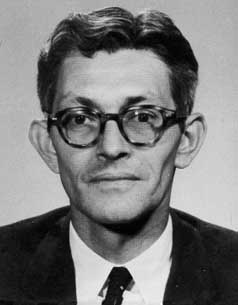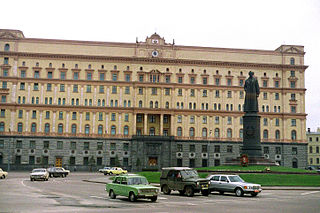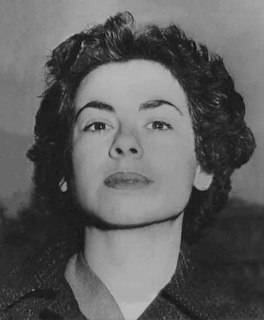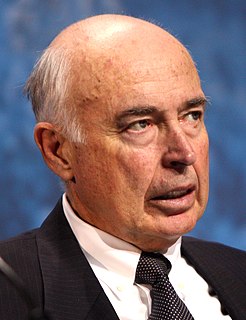Espionage, spying or intelligence gathering is the act of obtaining secret or confidential information (intelligence) from non-disclosed sources or divulging of the same without the permission of the holder of the information for a tangible benefit. A person who commits espionage is called an espionage agent or spy. Any individual or spy ring, in the service of a government, company, criminal organization, or independent operation, can commit espionage. The practice is clandestine, as it is by definition unwelcome. In some circumstances, it may be a legal tool of law enforcement and in others, it may be illegal and punishable by law.
Disinformation is a subset of propaganda and is defined as false information that is spread deliberately to deceive people. It is sometimes confused with misinformation, which is false information but is not deliberate.
In politics, soft power is the ability to co-opt rather than coerce. In other words, soft power involves shaping the preferences of others through appeal and attraction. A defining feature of soft power is that it is non-coercive; the currency of soft power includes culture, political values, and foreign policies. In 2012, Joseph Nye of Harvard University explained that with soft power, "the best propaganda is not propaganda", further explaining that during the Information Age, "credibility is the scarcest resource".
The Venona project was a United States counterintelligence program initiated during World War II by the United States Army's Signal Intelligence Service, which ran from February 1, 1943, until October 1, 1980. It was intended to decrypt messages transmitted by the intelligence agencies of the Soviet Union. Initiated when the Soviet Union was an ally of the US, the program continued during the Cold War, when it was considered an enemy.
A Red Scare is the promotion of a widespread fear of a potential rise of communism, anarchism or other leftist ideologies by a society or state. It is often characterized as political propaganda. The term is most often used to refer to two periods in the history of the United States which are referred to by this name. The First Red Scare, which occurred immediately after World War I, revolved around a perceived threat from the American labor movement, anarchist revolution, and political radicalism. The Second Red Scare, which occurred immediately after World War II, was preoccupied with the perception that national or foreign communists were infiltrating or subverting U.S. society and the federal government. The name refers to the red flag as a common symbol of communism.
In espionage jargon, a mole is a long-term spy who is recruited before having access to secret intelligence, subsequently managing to get into the target organization. However, it is popularly used to mean any long-term clandestine spy or informant within an organization. In police work, a mole is an undercover law-enforcement agent who joins an organization in order to collect incriminating evidence about its operations and to eventually charge its members.

James Jesus Angleton was chief of counterintelligence for the Central Intelligence Agency (CIA) from 1954 to 1974. His official position within the organization was Associate Deputy Director of Operations for Counterintelligence (ADDOCI). Angleton was significantly involved in the US response to the purported KGB defectors Anatoliy Golitsyn and Yuri Nosenko. Angleton later became convinced the CIA harbored a high-ranking mole, and engaged in an intensive search. Whether this was a highly destructive witch hunt or appropriate caution vindicated by later moles remains a subject of intense historical debate.

Active measures is political warfare conducted by the Soviet or Russian government since the 1920s. It includes offensive programs such as propaganda, espionage, sabotage, and assassination. The programs were based on foreign policy priorities of the Soviet Union.

Judith Coplon Socolov was a spy for the Soviet Union whose trials, convictions, and successful constitutional appeals had a profound influence on espionage prosecutions during the Cold War.
As early as the 1920s, the Soviet Union, through its GRU, OGPU, NKVD, and KGB intelligence agencies, used Russian and foreign-born nationals, as well as Communists of American origin to perform espionage activities in the United States, forming various spy rings. Particularly during the 1940s, some of these espionage networks had contact with various U.S. government agencies. These Soviet espionage networks illegally transmitted confidential information to Moscow, such as information on the development of the atomic bomb. Soviet spies also participated in propaganda and disinformation operations, known as active measures, and attempted to sabotage diplomatic relationships between the U.S. and its allies.
Subversion refers to a process by which the values and principles of a system in place are contradicted or reversed in an attempt to transform the established social order and its structures of power, authority, hierarchy, and social norms. Subversion can be described as an attack on the public morale and, "the will to resist intervention are the products of combined political and social or class loyalties which are usually attached to national symbols. Following penetration, and parallel with the forced disintegration of political and social institutions of the state, these tendencies may be detached and transferred to the political or ideological cause of the aggressor". Subversion is used as a tool to achieve political goals because it generally carries less risk, cost, and difficulty as opposed to open belligerency. Furthermore, it is a relatively cheap form of warfare that does not require large amounts of training. A subversive is something or someone carrying the potential for some degree of subversion. In this context, a "subversive" is sometimes called a "traitor" with respect to the government in power.
The Clandestine HUMINT page adheres to the functions within the discipline, including espionage and active counterintelligence.
At various times, under its own initiative or in accordance with directives from the President of the United States or the National Security Council staff, the Central Intelligence Agency (CIA) has attempted to influence public opinion both in the United States and abroad.
Counterpropaganda is a form of communication consisting of methods taken and messages relayed to oppose propaganda which seeks to influence action or perspectives among a targeted audience. It is closely connected to propaganda as the two often employ the same methods to broadcast messages to a targeted audience. Counterpropaganda differs from propaganda as it is defensive and responsive to identified propaganda. Additionally, counterpropaganda consists of several elements that further distinguish it from propaganda and ensure its effectiveness in opposing propaganda messages.

Angelo Maria Codevilla was an Italian-American professor of international relations at what is now the Pardee School of Global Studies at Boston University. He served as a U.S. Navy officer, a foreign service officer, and professional staff member of the Select Committee on Intelligence of the United States Senate. Codevilla's books and articles range from French and Italian politics to the thoughts of Machiavelli and Montesquieu to arms control, war, the technology of ballistic missile defenses, and a broad range of international topics. Articles by Codevilla have appeared in Commentary, Foreign Affairs, National Review, and The New Republic. His op-eds have appeared in The New York Times, The Wall Street Journal, The American Spectator and The Washington Post. He has also been published in Political Science Reviewer, Intercollegiate Review, and Politica.
Radio propaganda is propaganda aimed at influencing attitudes towards a certain cause or position, delivered through radio broadcast. The power of radio propaganda came from its revolutionary nature. The radio, like later technological advances in the media, allowed information to be transmitted quickly and uniformly to vast populations. Internationally, the radio was an early and powerful recruiting tool for propaganda campaigns.
The Interagency Active Measures Working Group was a group led by the United States Department of State and later by the United States Information Agency (USIA). The group was formed early during the Reagan administration, in 1981, as an effort to counter aggressive Soviet disinformation.
Herbert "Herb" Romerstein was an American ex-communist and historian who became a writer specializing in anticommunism and was appointed Director of the U.S. Information Agency’s Office to Counter Soviet Disinformation and Active Measures. As an author he is best known for his book The Venona Secrets.

Political warfare is the use of political means to compel an opponent to do one's will, based on hostile intent. The term political describes the calculated interaction between a government and a target audience, including another state's government, military, and/or general population. Governments use a variety of techniques to coerce certain actions, thereby gaining relative advantage over an opponent. The techniques include propaganda and psychological operations ("PsyOps"), which service national and military objectives respectively. Propaganda has many aspects and a hostile and coercive political purpose. Psychological operations are for strategic and tactical military objectives and may be intended for hostile military and civilian populations.

Dezinformatsia: Active Measures in Soviet Strategy is a non-fiction book about disinformation and information warfare used by the KGB during the Soviet Union period, as part of their active measures tactics. The book was co-authored by Richard H. Shultz, professor of international politics at Tufts University, and Roy Godson, professor emeritus of government at Georgetown University.








